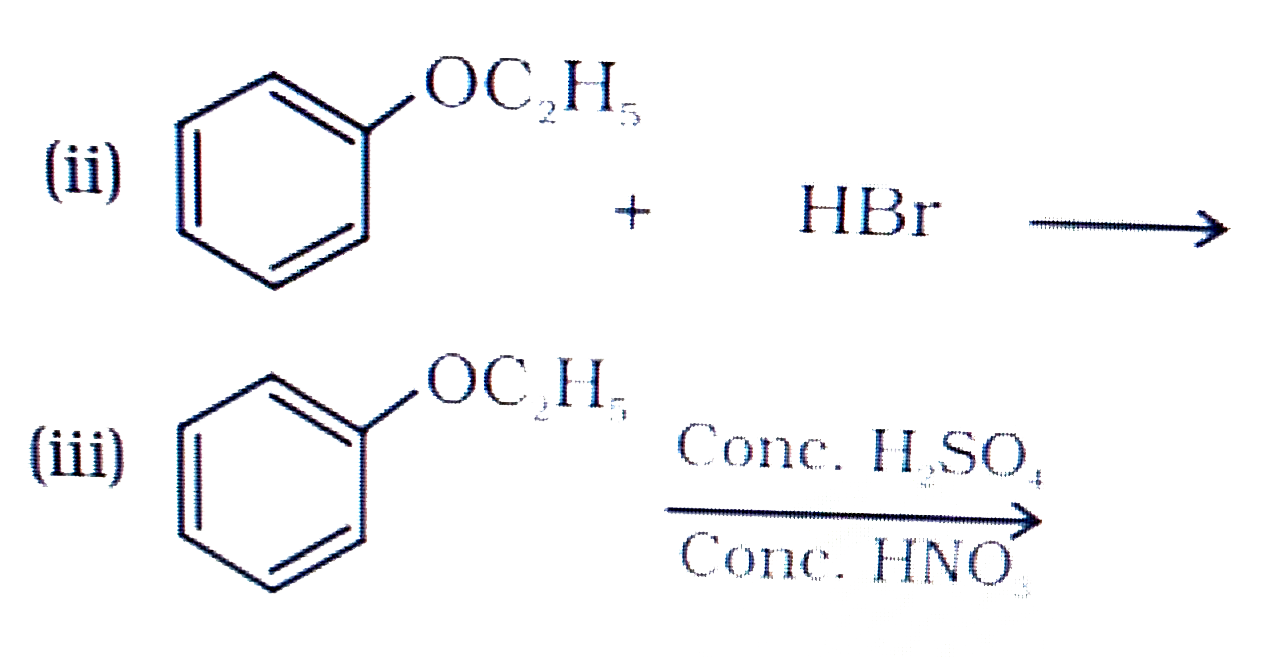Consider the reactions:
(i)(CH3)2CH−CH2BrC2H5OH−−−−→(CH3)2CH−CH2OC2H5+HBr
(ii)(CH3)2CH−CH2BrC2H5O−−−−−−→(CH3)2CH−CH2OC2H5+Br−
The mechanisms of reactions (i) and (ii) are respectively :
SN2 and SN1
SN1 and SN2
SN1 and SN1
SN2 and SN2
The correct Answer is:D
To solve the question regarding the mechanisms of the given reactions, we will analyze each reaction step by step.
Step 1: Analyze Reaction (i)
The first reaction is:
(CH3)2CH−CH2Br+C2H5OH→(CH3)2CH−CH2OC2H5+HBr
1. Identify the Reactant: The reactant is isobutyl bromide, which is a secondary alkyl halide.
2. Identify the Nucleophile: The nucleophile in this reaction is ethanol (C2H5OH).
3. Mechanism Consideration:
- In this reaction, the bromine atom (leaving group) departs first, forming a carbocation (a positively charged ion).
- The nucleophile (ethanol) then attacks the carbocation to form the ether product.
- Since the reaction involves the formation of a carbocation and does not involve a backside attack, it suggests an SN1 mechanism.
Step 2: Analyze Reaction (ii)
The second reaction is:
(CH3)2CH−CH2Br+C2H5O−→(CH3)2CH−CH2OC2H5+Br−
1. Identify the Reactant: Again, the reactant is isobutyl bromide (secondary alkyl halide).
2. Identify the Nucleophile: The nucleophile here is the ethoxide ion (C2H5O^-), which is a strong nucleophile.
3. Mechanism Consideration:
- In this case, the nucleophile attacks the carbon bonded to the bromine atom directly, leading to the displacement of the bromine atom.
- This reaction occurs in a single concerted step without the formation of a carbocation, indicating an SN2 mechanism.
Conclusion
Based on the analysis:
- Reaction (i) proceeds via an SN1 mechanism.
- Reaction (ii) proceeds via an SN2 mechanism.
Thus, the correct answer is:
Option B: SN1 for reaction (i) and SN2 for reaction (ii).
The first reaction is:
(CH3)2CH−CH2Br+C2H5OH→(CH3)2CH−CH2OC2H5+HBr
2. Identify the Nucleophile: The nucleophile in this reaction is ethanol (C2H5OH).
3. Mechanism Consideration:
- In this reaction, the bromine atom (leaving group) departs first, forming a carbocation (a positively charged ion).
- The nucleophile (ethanol) then attacks the carbocation to form the ether product.
- Since the reaction involves the formation of a carbocation and does not involve a backside attack, it suggests an SN1 mechanism.
The second reaction is:
(CH3)2CH−CH2Br+C2H5O−→(CH3)2CH−CH2OC2H5+Br−
2. Identify the Nucleophile: The nucleophile here is the ethoxide ion (C2H5O^-), which is a strong nucleophile.
3. Mechanism Consideration:
- In this case, the nucleophile attacks the carbon bonded to the bromine atom directly, leading to the displacement of the bromine atom.
- This reaction occurs in a single concerted step without the formation of a carbocation, indicating an SN2 mechanism.
Based on the analysis:
- Reaction (i) proceeds via an SN1 mechanism.
- Reaction (ii) proceeds via an SN2 mechanism.
Option B: SN1 for reaction (i) and SN2 for reaction (ii).
Similar Questions
Condiser the reactions,
(i) (CH3)2CH−CH2BrC2H5OH−−−−→(CH3)2CH−CH2OC2H5+HBr
(ii) (CH3)2CH−CH2BrC2H5O−−−−−−→(CH3)2CH−CH2OC2H5+Br−
The mechanism of reactions (i) and (ii) are respectively :View SolutionPredict the products of the following reactions:
(i) CH3−CH2−CH2−O−CH3+HBr→

(iv) (CH3)3C−OC2H5HI−−→View Solution
Knowledge Check
- Question 1 - Select One
The reaction, CH3COOC2H5Na+C2H5OH−−−−−−−−−−−→4[H]C2H5OH+CH3CH2OH , is called :
AClaisen reductionBClaisen condensationCBouveault-Blanc reductionDTischenko reduction - Question 2 - Select One
The reaction CH2=CH−CH3+HBr→CH3−Br∣CHCH3 is
Anucleophilic additionBfree radical additionCelectrophilic additionDelectrophilic substitution - Question 3 - Select One
Arrange the following compounds in order of their reactivity towards SN2 reaction.
(i) CH3(CH2)3CH2Br
(ii) (CH3)2CHCH2CH2Br
(iii) CH3CH2−CH3∣CH−CH2Br
(iv) CH3−CH3∣C∣CH3−CH2BrA(i)gt(ii)gt(iii)gt(iv)B(ii)gt(iii)gt(iv)gt(i)C(iii)gt(i)gt(ii)gt(iv)D(iv)gt(ii)gt(i)gt(iii)
Write mechanism of the following reaction:
CH3CH2OHHBr−−→CH3CH2Br+H2OView SolutionThe reaction is :
CH3CHBr−CH2Br+2KOH(alc.)Δ−−→CH3−C≡CH+2KBr+2H2OView SolutionThe given reaction is CH3−CH=CH−CH2OHHBr−−→CH3−Br∣CH−CH=CH2
View SolutionCH3−CH2−CH2−O−CH3 and CH3−CH3∣CH−O−CH3 are
View SolutionWhat is the correct IUPAC name for
CH3−CH∣C2H5−CH2−Br?View Solution
